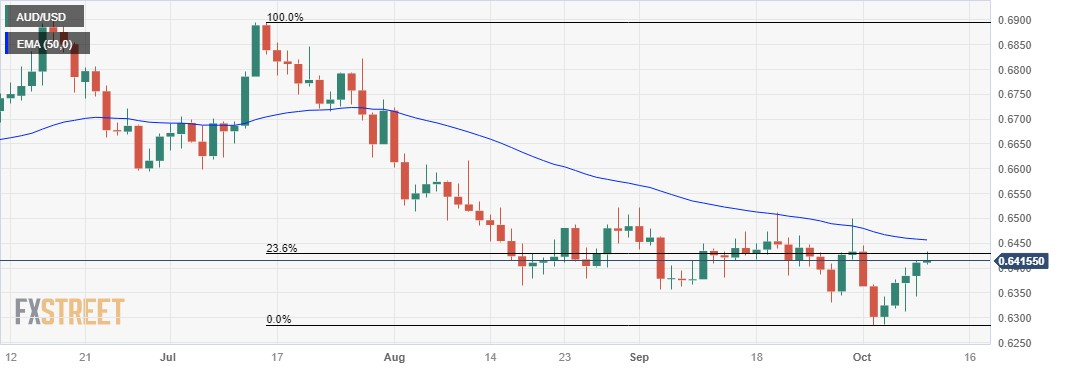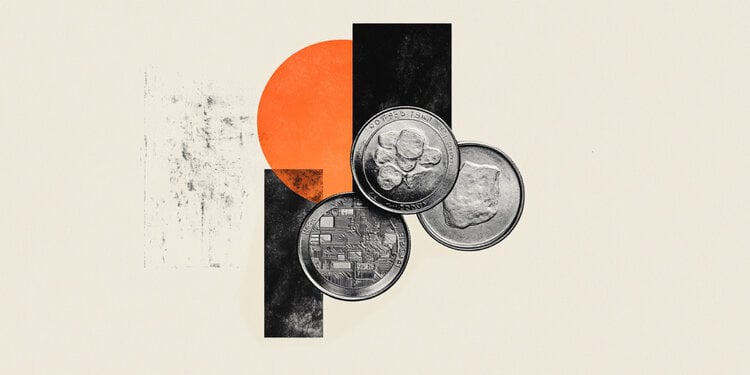- The Australian Dollar weakens due to the recovery of the US Dollar.
- The RBA is expected to raise interest rates by 25 basis points before the end of the year.
- Dovish comments from Fed officials contribute to pressure on the US dollar.
The Australian Dollar (AUD) breaks the four-day winning streak due to the recovery of the US Dollar (USD). However, the AUD/USD pair received upside support, driven by strong commodity prices and the ongoing conflict in the Middle East. Elsewhere, Westpac consumer confidence showed that individual confidence improved in October.
Australia experienced a rebound in inflation in August, mainly attributed to rising oil prices. This development increases the likelihood of another interest rate hike by the Reserve Bank of Australia (RBA).
If tension in the Middle East persists, it could contribute to further increases in oil prices, which could raise inflationary pressures on the Australian economy. This scenario could lead the RBA to apply an interest rate increase of 25 basis points (bp), placing them at 4.35% at the end of the year.
After holding talks with US senators on Tuesday, Chinese Commerce Minister Wang Wentao said that “both sides held rational and pragmatic discussions,” emphasizing the importance of the US-China economic and trade relationship.
Minister Wang conveyed that China is committed to fair competition based on international standards. He expressed hope that the US will precisely define the boundaries of security, urging to avoid politicizing and generalizing security issues.
The US Dollar (USD) failed to post significant gains despite strong US Nonfarm Payrolls data released on Friday. This lack of appreciation can be attributed to the decline in US Treasury yields on Monday.
Furthermore, statements by Federal Reserve (Fed) officials the previous day led investors to reduce the likelihood of further rate hikes, causing a further decline in US bond yields. This development is perceived as a weakening of the strength of the Dollar and provides a tailwind for the AUD/USD pair.
Daily Market Drivers Summary: Australian Dollar Receives Rising Support on Possible RBA Interest Rate Hike and Rising Commodity Prices
- The Westpac Australian Consumer Confidence Index showed current shopping conditions improved in October. The index rose 2.9%, compared to the previous decline of 1.5% recorded in September.
- The Australian stock market is experiencing a significant rise, driven mainly by a notable increase in commodity prices. This rise has translated into gains in all key sectors, particularly mining and oil stocks.
- Tensions in the Middle East could contribute to further increases in oil prices, which could raise inflationary pressures on the Australian economy.
- The increase in geopolitical tensions in the Middle East is contributing to increasing demand for raw materials such as energy and Gold, positively influencing the behavior of the AUD/USD pair.
- Australia has committed to ensuring a stable supply of energy resources to Japan at the fifth Japan-Australia Ministerial Economic Dialogue. This agreement reflects a strategic partnership between the two countries, emphasizing the importance of a reliable and constant flow of energy resources, which is likely to cover areas such as coal and Liquefied Natural Gas (LNG).
- Australia’s central bank could bet on a rate hike, with expectations pointing to a maximum of 4.35% by the end of the year. This projection is consistent with the persistent rise in inflation above the target.
- The US nonfarm payrolls report for September revealed a notable increase of 336,000 jobs, exceeding market expectations of 170,000. The revised figure for August stood at 227,000.
- US average hourly earnings (mom) remained stable at 0.2% in September, below the 0.3% forecast. In annual terms, the report indicated a rise of 4.2%, below the expected constant figure of 4.3%.
- US Treasury yields fell on Monday, with the 10-year Treasury yield at 4.64%.
- Dallas Fed President Lori Logan suggested there may be less need to raise the Fed funds rate, and Fed Vice Chair Philip Jefferson acknowledged the importance of the central bank proceeding cautiously in the face of any additional increase in the monetary policy rate.
- Investors are likely to closely monitor the upcoming International Monetary Fund (IMF) meeting, which will deliberate on strategies to stabilize international exchange rates and foster development.
- Traders will focus on the US Consumer Price Index (CPI) on Wednesday and Australian Consumer Inflation Expectations on Thursday, as these events play a key role in assessing inflationary trends. and economic conditions in both countries.
Technical Analysis: Australian Dollar moves below the psychological level of 0.6400
On Tuesday, the Australian Dollar is trading lower around 0.6390 against the US Dollar (USD). Key support lies at 0.6350, followed by the November low at 0.6272. These levels serve as crucial markers for possible changes in the trajectory of the AUD/USD pair. To the upside, the 23.6% Fibonacci retracement at 0.6429 presents itself as a major hurdle. A decisive break above this level could pave the way for the pair to explore higher levels, with the psychological level of 0.6450, aligned with the 50-day EMA at 0.6456 as a potential target.
AUD/USD daily chart
Australian Dollar FAQ
What factors determine the price of the Australian dollar?
One of the most important factors for the Australian Dollar (AUD) is the level of interest rates set by the Reserve Bank of Australia (RBA). As Australia is a resource-rich country, another key factor is the price of its largest export, iron ore. The health of the Chinese economy, its largest trading partner, is a factor, as is inflation in Australia, its growth rate and the Balance of Trade. Market sentiment, that is, whether investors bet on riskier assets (risk-on) or seek safe havens (risk-off), is also a factor, with the risk-on being positive for the AUD.
How do decisions by the Reserve Bank of Australia affect the Australian dollar?
The Reserve Bank of Australia (RBA) influences the Australian Dollar (AUD) by setting the level of interest rates that Australian banks can lend to each other. This influences the level of interest rates in the economy as a whole. The RBA’s main objective is to maintain a stable inflation rate of 2%-3% by adjusting interest rates up or down. Relatively high interest rates compared to other major central banks support the AUD, and the opposite for relatively low ones. The RBA can also use quantitative easing and tightening to influence credit conditions, with the former being negative for the AUD and the latter being positive for the AUD.
How does the health of the Chinese economy influence the Australian dollar?
China is Australia’s largest trading partner, so the health of the Chinese economy greatly influences the value of the Australian Dollar (AUD). When the Chinese economy is doing well, it buys more raw materials, goods and services from Australia, which increases demand for the AUD and drives up its value. The opposite occurs when the Chinese economy does not grow as fast as expected. Therefore, positive or negative surprises in Chinese growth data usually have a direct impact on the Australian Dollar.
How does the price of iron ore influence the Australian Dollar?
Iron ore is Australia’s largest export, with $118 billion a year according to 2021 data, with China being its main destination. The iron ore price, therefore, may be a driver of the Australian dollar. Typically, if the price of iron ore rises, the AUD also rises as aggregate demand for the currency increases. The opposite occurs when the price of iron ore falls. Higher iron ore prices also tend to result in a higher likelihood of a positive trade balance for Australia, which is also positive for the AUD.
How does the trade balance influence the Australian dollar?
The trade balance, which is the difference between what a country earns from its exports and what it pays for its imports, is another factor that can influence the value of the Australian dollar. If Australia produces highly sought-after exports, its currency will gain value solely from the excess demand created by foreign buyers wanting to purchase its exports versus what it spends on purchasing imports. Therefore, a positive net trade balance strengthens the AUD, with the opposite effect if the trade balance is negative.
Source: Fx Street
I am Joshua Winder, a senior-level journalist and editor at World Stock Market. I specialize in covering news related to the stock market and economic trends. With more than 8 years of experience in this field, I have become an expert in financial reporting.








